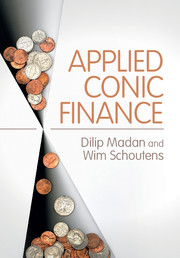Book contents
- Frontmatter
- Dedication
- Contents
- Preface
- Acknowledgements
- 1 Financial Mathematics Principles
- 2 Stochastic Processes and Financial Models
- 3 Numerical Techniques
- 4 Conic Finance
- 5 Conic Pricing
- 6 Applications of Conic Finance
- 7 Conic Portfolio Theory
- 8 Conic Hedging
- 9 Hedging Insurance Contracts
- 10 Option Positioning
- 11 Conic Trading
- References
- Index
11 - Conic Trading
Published online by Cambridge University Press: 27 October 2016
- Frontmatter
- Dedication
- Contents
- Preface
- Acknowledgements
- 1 Financial Mathematics Principles
- 2 Stochastic Processes and Financial Models
- 3 Numerical Techniques
- 4 Conic Finance
- 5 Conic Pricing
- 6 Applications of Conic Finance
- 7 Conic Portfolio Theory
- 8 Conic Hedging
- 9 Hedging Insurance Contracts
- 10 Option Positioning
- 11 Conic Trading
- References
- Index
Summary
In this final chapter we show how the conic finance machinery can be put to work to construct optimal trading policies (see also Madan et al. (2016a)). We work in a discrete time Markovian context. The specific activity considered is a simple one of linear positioning in a state-dependent manner on revenues that are correlated with the state transition. Hence one is positioned either to gain or lose the state transition. One may be viewed as going long or short the state transition and hence one is trading the Markov state variable.
We construct an optimal policy or trading strategy by maximizing a conic valuation objective that is the non-linear expectation for the risks undertaken. The aim is to implement such conservative valuations in a context that simultaneously permits the selection of revenue-generating actions that maximize this value.
In order to obtain tractable solutions, we will position ourselves in a steady state situation. The steady state solution is obtained using classical value and policy iteration schemes employed in the literature on Markov decision processes. However, it turns out to be critical here that the valuation is conducted by an expectation with respect to a non-additive probability, for with a classical conditional expectation operator both iterations fail. Since the valuation involves the use of non-linear conditional expectations as they arise in the conic finance modelling of two price economies, we refer to this as conic trading (in Markovian steady states). Hence we have a situation in which conic finance actually delivers solutions not available to one-price theories.
Much is written about algorithmic trading and the development of different and more sophisticated prediction algorithms, but they do not simultaneously incorporate the effect of the existing uncertainty around the prediction into the valuation of the strategy. In this chapter we provide a useful approach not only to evaluate prediction algorithms but also to include in the evaluation the effects of residual uncertainties.
We learn how the prediction benefits interact with the interests of hedging the underlying value function for strategies that are to be implemented in a stable environment in perpetuity.
- Type
- Chapter
- Information
- Applied Conic Finance , pp. 171 - 178Publisher: Cambridge University PressPrint publication year: 2016



